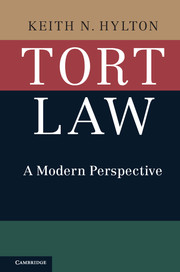Book contents
- Frontmatter
- Contents
- 1 Introduction
- 2 Policy and Tort Law
- 3 Evolution of Tort Law
- 4 Intentional Torts
- 5 Theoretical Foundations of Strict Liability
- 6 The Reasonable Person
- 7 Customs, Statutes, and the Reasonable Person
- 8 Inferring Negligence
- 9 Contributory Negligence and Assumption of Risk
- 10 Contributory Negligence, Comparative Negligence, and Incentives for Care
- 11 Joint and Several Liability, and Vicarious Liability
- 12 Factual Causation
- 13 Proximate Cause
- 14 Duty to Rescue and Special Relationships
- 15 Strict Liability: Conversion, Abnormally Dangerous Activities, and Nuisance
- 16 Defamation
- 17 Products Liability
- 18 Damages
- Index
14 - Duty to Rescue and Special Relationships
Published online by Cambridge University Press: 05 June 2016
- Frontmatter
- Contents
- 1 Introduction
- 2 Policy and Tort Law
- 3 Evolution of Tort Law
- 4 Intentional Torts
- 5 Theoretical Foundations of Strict Liability
- 6 The Reasonable Person
- 7 Customs, Statutes, and the Reasonable Person
- 8 Inferring Negligence
- 9 Contributory Negligence and Assumption of Risk
- 10 Contributory Negligence, Comparative Negligence, and Incentives for Care
- 11 Joint and Several Liability, and Vicarious Liability
- 12 Factual Causation
- 13 Proximate Cause
- 14 Duty to Rescue and Special Relationships
- 15 Strict Liability: Conversion, Abnormally Dangerous Activities, and Nuisance
- 16 Defamation
- 17 Products Liability
- 18 Damages
- Index
Summary
NO DUTY TO RESCUE RULE
An oft-repeated rule of tort law states that there is no duty to rescue. However, like many such rules, this one raises more questions than it answers. For example, what does it mean to rescue? Does the absence of a rescue duty imply that you never have a duty to take care to minimize the harm to someone that might be caused by a third person? If so, how can the rule be reconciled with the proximate cause cases of the previous chapter? The no duty to rescue rule begs the question of what it means to have a duty to rescue. The case law offers some answers to these questions and at the same time reveals policy-based exceptions to the no-duty rule.
Another way of looking at the rule was described in one American case as follows:
There is a wide difference – a broad gulf – both in reason and in law, between causing and preventing an injury…The duty to do no wrong is a legal duty. The duty to protect against wrong is, generally speaking and excepting certain intimate relations in the nature of a trust, a moral obligation only, not recognized or enforced by law.
The distinction between a duty not to do wrong and a duty to protect against wrong resembles the famous distinction between positive and negative liberties. Negative liberty is freedom to take, or not to take, action that may harm others. Positive liberty is freedom to act, or not to act, in a way that enhances your own welfare or that of others. Tort law restrains negative liberty by holding you liable if you take actions that harm others. However, the rescue doctrine says, in effect, that tort law puts no restraints on positive liberty, because it does not compel you to act to enhance someone else's welfare.
All of this sounds intuitive and reassuring, but these propositions do not take you far in the case law. To make sense of the rescue cases, we will have to look at examples and build up toward a general sense of the doctrine, examining one case after another.
Take the most straightforward example to start. The no duty to rescue rule applies to a potential rescuer who chances upon someone drowning in a lake.
- Type
- Chapter
- Information
- Tort LawA Modern Perspective, pp. 254 - 270Publisher: Cambridge University PressPrint publication year: 2016



